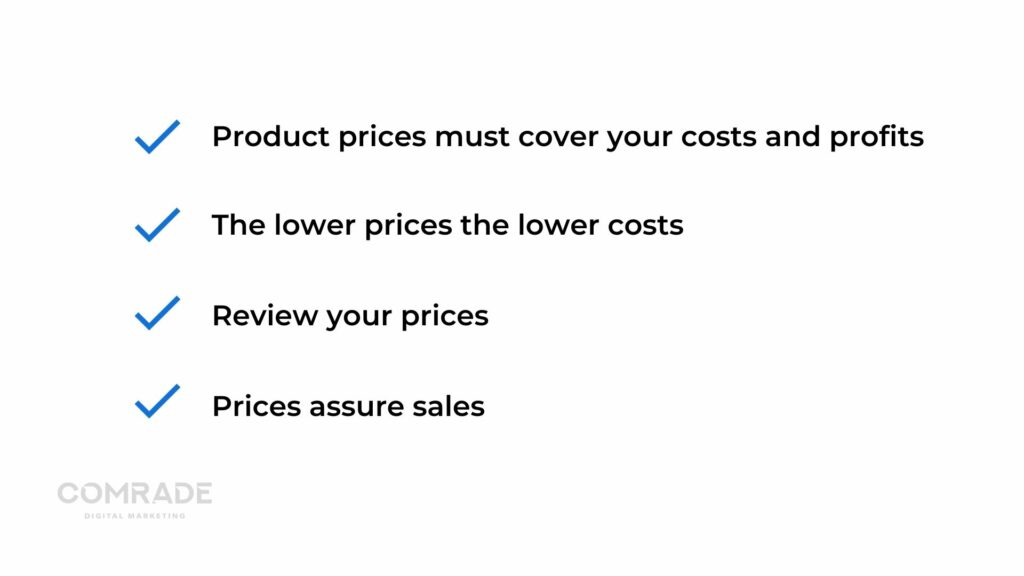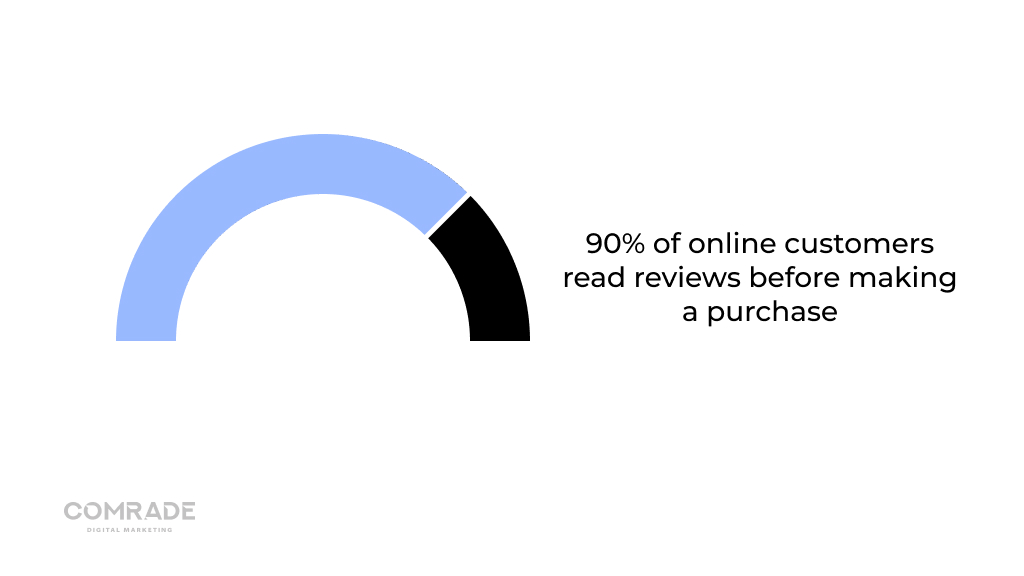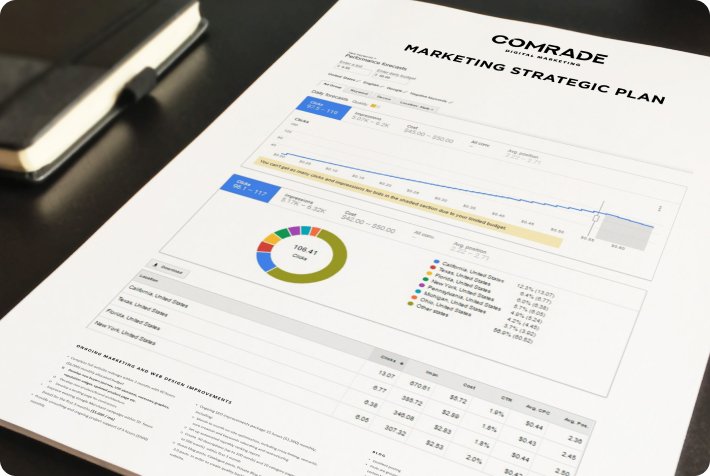The usual reasons and ones that we often see as marketers can usually be whittled down to:
- Not having a cohesive digital marketing strategy
- Poor knowledge of how digital marketing connects consumers and business
- The inability to attract qualified traffic
- Targeting the wrong traffic
- Selling products with low demand.
In this blog, we’ll discuss the most common mistakes eCommerce businesses make, and how they can fix them to boost conversions and drive sales.
Why Ecommerce Sales Matter
When your sales are high, you improve cash flow and your brand’s reputation. In fact, accelerating sales is very much the keystone to a successful eCommerce business.
If your eCommerce site isn’t selling, you should seek professional assistance with online marketing and website building. We’ve seen time and again how business owners have great ideas but poor execution, and all they need is professional help to turn their eCommerce sites around.
Not only are consumers constantly changing the way they shop, they expect a seamless online experience. It doesn’t matter if you’re a small brand, they’ll compare your service delivery to Amazon’s.
Now companies are creating digital-first approaches to create loyal customers. If customers require a garden service, they’ll search on Google, where they “meet” hundreds of businesses promoting unique offerings.
Therefore, you have to be online because that’s where your customers are, making the eCommerce sales all the more pertinent to business longevity.
How to Improve Your Ecommerce Site’s Sales
Here at Comrade, we focus on the following 12 factors to increase eCommerce sales. And you should, too!
1. Develop a Digital Marketing Strategy

We don’t have to tell you that selling online is highly competitive, and you require a plan to cut through the noise and aggressively target your audience with laser precision. In simple terms, digital marketing is a set of planned actions performed online to reach your specific business goals.
It entails performing consistent actions at the right time via the most suitable online channels to encourage more sales and strengthen your relationships with your customers. You can’t just have an online store and expect people to find you among the other 1.7 billion websites on the World Wide Web.
So, how do you reach customers? You have to leverage websites, search engines, blogs, social media, videos, email, and paid ads. Having an SEO-friendly eCommerce website is the first step. The next is developing a plan to promote your products and services across the internet.
Before creating your strategy, you’ll want to identify your target audience. These are the kinds of people who buy your products and services.
Unlike traditional marketing, digital marketing is highly targeted so knowing your customers’ needs and wants and how they behave online helps you reach them with the right messaging on the appropriate channels.
You also can’t develop a strategy without defining your business goals. So, make sure your marketing and business objectives are crystal clear.
2. Improve Traffic Volume

Website traffic refers to the number of people who visit your eCommerce site. Now, obviously low traffic means low sales. However, while high traffic is a positive signal, it doesn’t always translate into sales.
Let’s address a lack of traffic first.
There are two ways to get site visitors:
- either through organic traffic or
- paid ads.
Organic traffic is more important because it relies on a long-term SEO strategy. Search engine optimization, called SEO for short, is more complex and delivers a higher ROI than paid ads.
How on-page SEO basically works is like this: When users type phrases (keywords) into Google, the search engine scans websites to identify those with the same keywords. Once it finds these websites, it ranks them (according to 200 different factors) and presents them in Google search results.
So, let’s say your eCommerce platform sells gluten-free products, and you know your audience is actively seeking these online. In theory, you’ll ensure your content marketing and web copy has the same keywords your audience searches for, which might be “gluten-free pasta,” “What is gluten-free,” “Is bread gluten-free?” and so on.
Now, what if your keyword strategy is good, but you’re not converting customers? This is likely because your website is poorly designed, or your calls to action aren’t clear (See the next point.).
3. Write Better CTAs
A call to action (CTA) is an image or a line of text that prompts visitors, leads, and customers to take a specific action. Typically, it grabs a potential customer’s attention and directs them to make a purchase.
On most eCommerce product pages there’s a button that visitors click on to make a purchase. Usually, it says, “buy product” or “add to cart.” If your CTAs aren’t clear then your visitors won’t know what to do and will leave your website.
The most effective CTAs resemble buttons. How they look is up to you. The real goal is to have great ones that encourage visitors to click on them. You can do this by making them bright and bold, and placing them in areas with white space to make them stand out.
4. Fix a Broken Sales Funnel

A sales funnel is a marketing concept that maps out the journey a customer goes through when making a purchase from your online store. If your sales funnel isn’t clearly defined and critically measured, you’ll struggle to maximize eCommerce sales.
We help eCommerce business break down their marketing funnel into constituent parts and analyze the corresponding data. Marketing is data-driven, so if you’re not looking at the numbers, and comparing them to industry standards and your eCommerce KPIs, you won’t know where and how to improve.
Our experts use a variety of analytical tools to track a customer’s journey and pinpoint at exactly what stage (awareness, interest, decision, action) they’re not converting. Occasionally, this requires redefining their sales funnel too.
So, there are two things you can do to fix a broken sales funnel: Firstly, you need to map out your customer’s journey and align your marketing efforts to meet them at each stage, and secondly, you need to analyze the data.
5. Define Your Audience

You used to be able to say your target audience, was, for example, housewives between the ages of 30 to 45 with two kids, who didn’t have domestic help and needed a strong hoover. Times have changed, and not just for women.
Now, you need to be even more specific. Do these mothers work full or half-time jobs? What devices do they use? Where do they live? Which social media channels do they use the most? What other lifestyle brands do they purchase? What are their political views? Their interests and hobbies? Etc.
Granular preferences matter because social media marketing allows you to target your audience based on their interests, and even other businesses they have interacted with online. So, take the time to really get to know them.
It’s also common for eCommerce businesses to have more than one kind of customer. For instance, you might appeal to mothers who love the outdoors, as well as those who’d rather spend time at home. This is called audience segmentation.
Creating buyer personas will ensure you attract the right traffic (consumers).
6. Choose the Right Marketing Channels

The channels through which you market also dictate your sales. The minute a new social media channel gains traction, businesses panic thinking they need to jump on the trend and start selling on the platform.
While it’s good to be aware of the market and customer behavior, not every channel is suitable for every audience. Using marketing channels like TikTok that are popular with Gen Z when selling products aimed at Gen X, for instance, won’t help.
You only have to invest time and resources into the most impactful channels and tactics. The easiest way to select the right channels is to know your audience and conduct competitive market research.
You see, it all comes down to having a digital marketing strategy, which takes time to research, develop and refine!
7. Sell the Right Products at the Right Price

If your marketing strategy is solid and your eCommerce site is up to scratch, the issue could be with your actual products. They may be too expensive, unappealing to your target audience or not as good as your competitors.
The only way to know for sure is through market research and testing. Most eCommerce business will test their products with focus groups before launching full-scale.
You can ask your focus group the following questions:
- Does this product solve a problem in your daily life? If not, how does it add to your life?
- What would you pay for this product?
- Is there anything you would improve?
Market testing is vital to product development. It’ll help you understand and collect customer feedback. Importantly, it’ll confirm whether there are people interested in your product and can pinpoint where you need to fine-tune product performance before a full-scale launch.
Pricing, on the other hand, can be more complicated, yet the basic rules are as follows:
- Product prices must cover your costs and profits.
- If you have to lower your prices, you should lower your costs.
- Review your prices frequently, so they reflect market demand, and profit goals, and are relative to your competition.
- Prices should assure sales.
If you ask too little your profit margin decreases or your customers assume your products are subpar. The right price always covers your costs, maximizes your margins and remains attractive to customers.
8. Ensure High-Quality Presentation
Highly pixelated photos, poor sales copy and inadequate product descriptions can result in abandoned carts and no sales. Be honest. Are you doing everything you can to make your products look good?
Good presentation is everything to do with how your website and product pictures look. Put it this way. When a visitor arrives at your online store will they want to buy what you offer?
As a general rule of thumb, your images need to be high-quality. An eCommerce website should display multiple product angles. Remember, your customers can’t physically inspect your products as though they’re in a store, so you must provide as much visual information as possible.
Then there’s also website design to consider. Are the pages clearly laid out? Do they look cluttered or are they spacious with white space to increase readability?
Keep it clean and simple. Nobody likes clutter. The more intuitive, the better, so visitors can find what they need. When customers visit your site, they need to know (within seconds) who you are and what you sell or what solution you provide.
If aesthetics aren’t your strong point, then we recommend hiring a website designer to ensure you showcase your brand and products in the best light online.
9. Include Testimonials

Did you know that 90% of online customers read reviews before they make a purchase? If you want to improve your conversion rate, you need to let customers know what other people think of your products.
Customer reviews and testimonials establish brand credibility. They work because they aren’t “strong” sales pitches and come across in an unbiased way. Essentially, they demonstrate how real people enjoy your products or services.
Think about it like this. Let’s say your business specializes in meal kits. The first thing new customers will want to know is if your food tastes good. If you don’t have reviews on your eCommerce site, but your competitors do, your customers will probably choose them. Here lies the power of reviews!
Depending on your business, you can incorporate reviews in several ways. Some businesses create professional testimonials, while others have built-in review requests part of their apps or ask for reviews via email or on social media.
Lastly, reviews factor into how Google ranks your eCommerce website. It deems those with reviews to have greater credibility and ranks them higher. This is especially true for local SEO.
10. Focus on Retention if Your Niche Is Competitive
When an eCommerce business is in a competitive niche, it has to have a brilliant marketing plan that makes it stand out. Beyond this, it should focus on retention to ensure its brand grows steadily over the long run.
In fact, customer retention can be five to twenty-five times cheaper than customer acquisition. So, if you’re only getting a handful of visitors every day, but they’re the right traffic, and you’re retaining them, your audience will grow over time.
What this means is you need to build a steady relationship and engage with them once they’ve shown an interest. It’s common for eCommerce businesses to encourage leads to follow them online, or follow-up conversions with an email drip marketing campaign.
Developing a lead capture form to collect their information (email addresses) in exchange for product demos, discount codes or guides is a simple way to keep in touch and nurture positive relations.
You should also continuously educate customers by providing up-to-date information about products and services. This includes sharing milestones or product launches. Creating and distributing personalized content for different customer segments via email is also a good strategy.
Of all digital marketing channels, email marketing has one of the highest ROIs, generating $36 for every $1 spent!
11. Optimize Landing Pages

The best way to optimize your landing pages is to make them user-centric. Unlike a homepage, landing pages exist to convert targeted traffic into customers or repeat users. They are designed to capture sales leads or directly sell products.
Therefore, their value proposition needs to be clear. Most landing pages should only have one CTA like encouraging signing up for a newsletter or free trial, purchasing a product or contacting a sales representative.
The most common mistake business make is overcomplicating their landing page designs and not making a single, clear offer. A good content writer should be able to help you craft crisp and compelling copy that engages visitors.
Another critical factor is the length. Forms that are too long dissuade customers from filling them in. They simply won’t complete all the fields. So, find a balance between collecting necessary information without making a chore out of it.
12. Simplify Your Checkout Process
An eCommerce site not selling may have a complicated checkout process or limited payment options. Did you know that 1 out of every 5 shoppers abandons their carts due to a too long or complicated checkout process?
To improve your eCommerce store checkout process avoid superfluous design elements that disrupt the process. Ideally, your checkout process should involve the following:
- Checkout
- Delivery details
- Multiple payment options
- Confirmation
Furthermore, don’t try to advertise more products at this stage. The last place you should attempt this is on the basket page. For instance, if your customer is interested in adding more products to qualify for free shipping. You can also increase their average order value here by recommending related products.
Finally, you’ll also want to create a clear and concise order review. This is where customers can see the full price and confirm the products in their cart before entering their personal details and selecting a shipping method.
Find Digital Marketing Strategists You Can Trust and Hire Them!
All these recommended fixes come down to having a comprehensive marketing strategy designed to increase product sales.
Need help? Don’t fret. The team at Comrade Digital Marketing Agency can assist with everything from Google Analytics to search volume, designing your website, SEO and more.
The most important part is finding a digital agency that understands your eCommerce store and that you can trust.
That’s why we’re the first eCommerce digital marketing firm to offer a guarantee on our work. We’d love to hear more about your eCommerce business and discuss how we can help. Why not schedule a free, non-obligatory consultation?
Frequently Asked Questions
Where can I find your company?
Comrade originates in Chicago, but we worked all around the United States. We can help your business grow and increase revenue whenever you are. We have offices across most major cities in the US. For example, we can offer digital marketing services in Baltimore or Seattle. You can even find our internet marketing experts in Atlanta! If you want to know more about our Madison digital marketing agency or find out how exactly we can help you, contact us via the phone or email.




